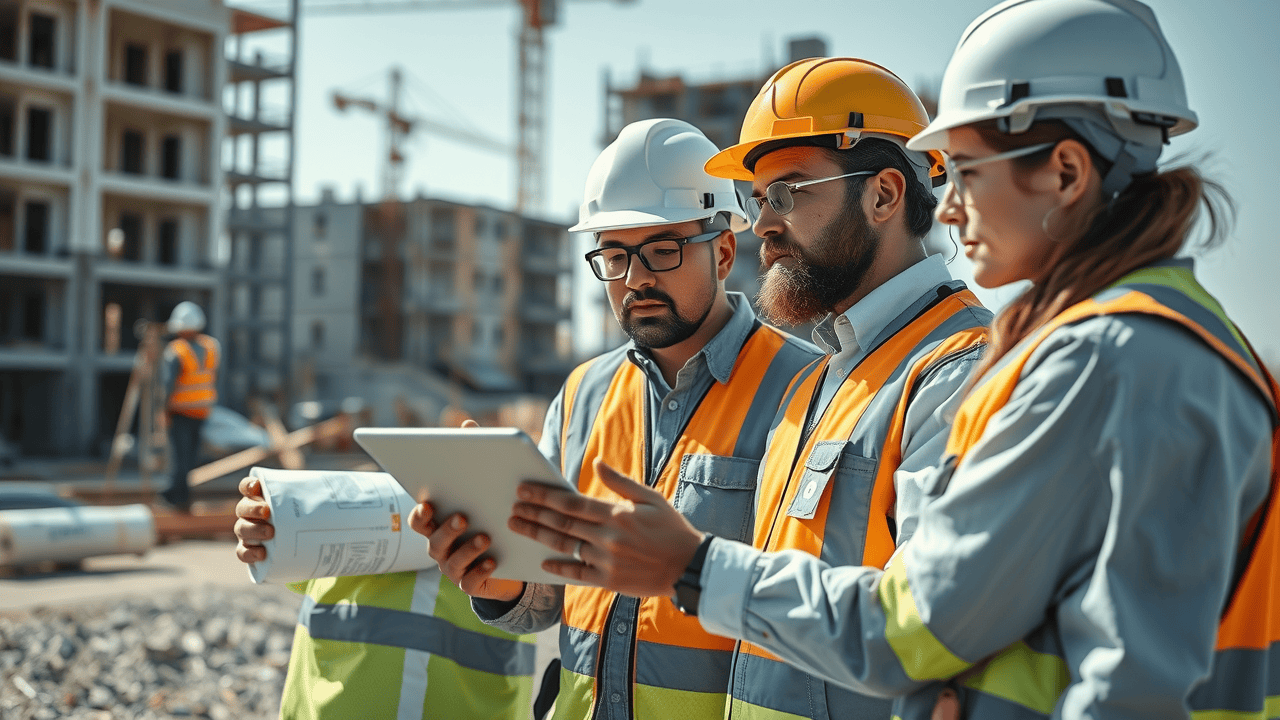Did you know that integrating 3D as-built surveys can cut construction rework by up to 50%? In today’s fast-changing construction industry, mistakes can mean costly rework and serious delays. That’s why more project leaders are turning to cutting-edge technology like laser scanning and advanced surveying techniques to drive accuracy and efficiency from the ground up. This essential guide breaks down exactly how 3D as-built surveys improve accuracy in construction—revealing the transformative benefits for quality control, project management, and long-term facility success.

A Game-Changer: Startling Statistics on How 3D As-Built Surveys Improve Accuracy in Construction
The impact of accurate as-built data on construction projects is dramatic. According to multiple industry sources, introducing 3D as-built surveys with laser scan and scanning services offers substantial reductions in errors and schedule slip. For example, companies using these advanced surveying methods experience an average reduction in costly rework by up to 50%. By leveraging point cloud data, millions of precise measurements can be captured much faster than with traditional survey approaches, cutting down both time and expense. For project managers, this means more informed decisions based on highly accurate digital representations and a smoother construction process from start to finish.
“According to industry studies, leveraging 3D as-built surveys has reduced rework on construction projects by up to 50%.”
Accuracy isn’t just about getting numbers right; it’s about real savings, peace of mind, and consistently delivering projects on schedule. Discover how this powerful shift in approach can elevate any construction project, keeping your teams ahead and your budgets on track.
What You’ll Learn About How 3D As-Built Surveys Improve Accuracy in Construction
- The role of laser scan and laser scanning in precise as-built documentation
- Key differences between traditional survey and modern surveying methods
- How point cloud data enhances quality control for construction project management
- Comparing scanning services, technologies, and their impact on facility management
- Core benefits of accuracy, efficiency, and safety across construction projects
Understanding How 3D As-Built Surveys Improve Accuracy in Construction
Defining 3D As-Built Surveys
3D as-built surveys use advanced laser scanning technology to capture a digital representation of a building, structure, or construction site as it truly exists at a given moment. Unlike traditional surveying methods, which may only record select measurements, 3D as-built surveys collect millions of data points to create a dense, point cloud. This comprehensive information forms the foundation for creating building information or digital twins, which play a pivotal role in modern construction project management. The process involves deploying a laser scanner on-site, which emits laser pulses and records the time it takes for each pulse to reflect off surfaces and return. The result is a highly accurate map—detailing every beam, column, wall, pipe, and feature—critical for reliable decision-making, planning, and ongoing facility management.

Core Challenges in Accuracy for Construction Projects
Accuracy challenges in construction projects stem from limitations in traditional surveying methods, manual errors, and evolving job site conditions. Inaccurate measurements can cascade into costly rework, project delays, and disputes among project stakeholders. Traditional surveys may overlook subtle deviations, introducing errors when updating plans or coordinating new work. In contrast, 3D as-built surveys provide an all-encompassing data set that reflects the state of every aspect of the site at the time of scanning. This reduces the risk of missing critical details, catching errors early, and enabling precise coordination—crucial for large, complex, or high-risk construction projects. By shifting toward laser scan and point cloud technology, construction teams can be proactive, rather than reactive, when addressing discrepancies between planned and actual site conditions.
Role of Laser Scan and Laser Scanning Technology
Laser scanning technology is the backbone of modern 3D as-built surveys. These advanced instruments use rapid, high-frequency lasers to capture millions of data points within minutes, drastically outpacing what human surveyors can achieve. Modern laser scanners can operate in challenging conditions—indoors, outdoors, and even at night—making them unmatched for capturing the real state of a project. The result: a highly detailed point cloud data set that serves as the basis for building information modeling (BIM), digital twins, and other powerful construction analytics tools. This wealth of information not only supports quality control but also enables complex tasks like clash detection, progress verification, and precise measurements for renovations or maintenance projects.
Traditional Survey vs. 3D As-Built Surveys: A Comparative Analysis
Both traditional survey and 3D as-built surveys aim to document construction projects, but their methods and results couldn’t be more different. Where traditional surveying relies on manual measurements taken at set intervals, 3D as-built surveys use laser scan technology for highly accurate, dense, and rich point cloud data. The contrast is clear in metrics like accuracy, time, and cost—where as-built scanning services offer significant advantages for any construction project.
| Criteria | Traditional Surveying Methods | 3D As-Built Surveys (Laser Scanning) |
|---|---|---|
| Accuracy | Moderate – Subject to human error, limited data points | Highly Accurate – Millions of data points in a single scan |
| Time Required | Slow – Manual measuring & recording | Fast – Site-wide surveys in hours, not days |
| Cost | Potentially high due to rework and repeated visits | Lower overall – Reduces costly rework, fewer site returns |
| Quality Control | Limited – Point checks only, missing subtle issues | Extensive – Supports clash detection, verifies dimensions |
| Point Cloud Integration | Not possible | Fully compatible for BIM, facility management, and more |
As shown above, the advantages of adopting laser scan and scanning services for 3D as-built surveys are clear: greater accuracy, fewer errors, improved quality control, and a quicker path to project completion.
Inside the Technology: How Laser Scan & Laser Scanning Work in Construction Projects
Step-by-Step Process of Laser Scanning Services
The journey from an active construction site to a digital, 3D-ready as-built model begins with careful planning and the right laser scanning equipment. First, scanning professionals assess the site for optimal scanner placement, ensuring full coverage without blind spots. Next, the laser scanner is set up on a tripod at multiple strategic points around the area. The device emits lasers at high frequency, collecting millions of data points with each sweep. Every scan records not just XYZ positions, but also the reflectivity of materials, spatial relationships, and intricate structural features. After scanning, technicians process the raw cloud data in specialized software to remove noise and align individual scans into a unified, highly accurate digital representation of the project.
From Scan to Point Cloud: Data Capture to As-Built Models
Once laser scanning is complete, the data is transformed into a dense point cloud—essentially, a three-dimensional map made up of millions or even billions of individual data points. This point cloud data is a digital twin of your construction project, capturing every detail down to the inch. From this, surveyors and BIM professionals can create as-built models in standard CAD or Building Information Modeling (BIM) formats, enabling thorough quality control, easy coordination, and precise planning for ongoing work or future renovations. The end product is a rich, visual representation that can be shared, analyzed, and manipulated with far more confidence than anything a traditional survey could offer.
Watch a demonstration of 3D laser scanning in action on a live construction project.
How 3D As-Built Surveys Improve Accuracy in Construction Projects
Reducing Human Error and Increasing Precision
Human error is a persistent problem for every construction project. Manual measurements, transcription mistakes, and communication breakdowns can all result in misalignment, costly rework, and missed deadlines. 3D as-built surveys virtually eliminate these risks by relying on laser scanning technology to automatically capture millions of data points with pinpoint consistency. The result: incredibly accurate renderings of the site that allow teams to check dimensions, spot issues early, and make truly informed decisions. With so much accuracy built into the digital workflow, project managers gain a reliable foundation for every subsequent phase of the build. Mistakes can be identified and resolved long before they turn into expensive problems, setting a new standard for efficiency and precision in the construction industry.

Supporting Quality Control and Compliance
Quality control is at the core of successful construction projects, especially when multiple teams and complex components are involved. Laser scanning services provide comprehensive dimensional data and point cloud references that can be cross-checked against design models to verify compliance at every phase. This not only supports contractors in meeting strict quality standards but also assists regulatory bodies in ensuring that structures adhere to legal and safety requirements. Because 3D as-built surveys can be performed at key milestones throughout a construction project, issues like misalignment, code violations, or missed specifications can be caught and remedied early—eliminating the risks associated with incomplete or inaccurate documentation from traditional survey methods.
Facilitating Project Coordination and Change Management
Effective coordination between architects, engineers, contractors, and owners is vital for on-time delivery and budget control. By sharing highly accurate as-built models and digital representations, teams can collaborate with full confidence in the project’s current state—preventing confusion, scope changes, and costly disputes. Laser scan data supports rapid change management by providing a reliable reference point for any modification, whether it’s a structural addition, rerouting utilities, or adjusting schedules. Not only does this streamline project coordination, but it accelerates approvals and reduces the stress of unexpected site conditions. The transparency brought by point cloud data fosters trust among stakeholders and paves the way for smarter, faster decision-making throughout the lifecycle of the construction project.
Real-Life Success Stories: How 3D As-Built Surveys Improved Construction Project Outcomes
Case studies abound for companies that have embraced scanning services. For instance, a commercial development in a large city called on 3D as-built surveys to verify complex mechanical installations. The scanning process revealed several elements that were misaligned from the original design. By catching these discrepancies early, the construction company avoided major rework and prevented project delays. In another example, a hospital expansion project used laser scan technology to update as-built models before proceeding with critical structural modifications, ensuring all additions fit perfectly and complied with safety codes.
“Using 3D as-built surveys, our firm spotted critical errors in the early construction phase, saving thousands in potential rework.”
These real-world gains demonstrate why leading general contractors, architects, and engineers rely on laser scanning not only for accuracy and speed but also for confidence in client handovers and lifetime asset value.

Applications Beyond Construction: Facility Management and Lifecycle Benefits
Scanning Technology for Facility Management and Asset Documentation
The benefits of 3D as-built surveys extend far beyond the completion of any construction project. Facility managers, maintenance teams, and asset owners use the rich point cloud data and as-built models for ongoing management, renovations, and upgrades. With complete digital representations readily available, facilities can be mapped, monitored, and managed with ease—reducing the risk of costly mistakes during future work. Scanning technology supports precise documentation of mechanical, electrical, and HVAC systems, enabling seamless integration with facility management software and digital twins. This holistic approach streamlines everything from preventive maintenance scheduling to strategic planning for refurbishments, keeping assets operational and compliant over their entire lifespan.

Supporting Ongoing Maintenance with Accurate As-Builts
Accurate as-built models are crucial for ongoing maintenance and facility operations. When issues arise—whether a pipe bursts, an electrical system requires upgrades, or space usage needs to change—the digital record provided by laser scan ensures that teams have complete and up-to-date information. This not only speeds up troubleshooting but allows for safer, more effective interventions. By integrating accurate point cloud data with facility management platforms, building owners can reduce risks, avoid redundancy, and support better decision-making for years to come.
Key Benefits: Why Choose 3D As-Built Surveys and Scanning Services?
- Improved Accuracy for As-Built Documentation
- Enhanced Quality Control
- Greater Cost and Time Savings
- Streamlined Project Coordination
- Better Facility Management
Each of these benefits—backed by laser scan and scanning services—adds up to significant improvements in construction quality, efficiency, and safety.
Considerations When Choosing 3D As-Built Scanning Services
Evaluating Scanning Technology Options
Not all scanning technologies or equipment are created equal. When evaluating scanning services, consider factors such as scan range, data resolution, ability to handle complex geometries, and compatibility with your preferred BIM or CAD software. Some services offer rapid scanning that is best for broad coverage, while high-detail scanners may be ideal for dense MEP installations or historical restorations. Matching the laser scanner to your project ensures you’ll get the most value and most accurate representation for your needs.
Selecting Qualified Providers for Maximum Benefit
Choosing the right team to perform 3D as-built surveys is as important as the technology itself. Look for providers with experienced staff, a track record of accurate point cloud deliveries, and the ability to work closely with your construction team from planning through post-processing. Effective communication, safety credentials, and deep familiarity with your industry segment are essential. Quality scanning services offer full support—including pre-scan consultation, on-site scanning, data processing, and integration with your chosen project management tools for seamless workflows.
| What to Look For | Details/Best Practices |
|---|---|
| Technology & Equipment | High-detail laser scanners, compatibility with BIM platforms, fast data processing |
| Provider Experience | Proven track record, positive client references, knowledge of specific construction project types |
| Service Support | Full-service from planning to data integration, responsive to project needs |
| Data Transparency | Accessible, well-documented point cloud data and deliverables |
| Compliance & Safety | Certified staff, rigorous safety adherence, clear insurance and liability coverage |
People Also Ask About How 3D As-Built Surveys Improve Accuracy in Construction
How do 3D as-built surveys work in construction?
3D as-built surveys use laser scanning technology to capture highly detailed measurements of existing structures as point cloud data, reducing errors and providing accurate digital models for project planning and quality control.
What are the advantages of using laser scanning over traditional surveying methods?
Laser scanning offers superior accuracy, speed, and data richness compared to traditional surveying methods, enabling quick capture of complex environments and supporting better decision-making on construction projects.
Can 3D as-built surveys improve facility management post-construction?
Yes, 3D as-built surveys provide detailed digital records of structures, supporting efficient facility management, renovations, and ongoing maintenance across the asset’s lifecycle.
Frequently Asked Questions: How 3D As-Built Surveys Improve Accuracy in Construction
How is point cloud data used in construction projects?
Point cloud data is used to create highly accurate 3D models of construction sites, supporting everything from clash detection and quality control to future design and maintenance. Construction professionals rely on this dense data for as-built verification, progress tracking, and precision renovations—ensuring that every change is based on a real-world, up-to-date digital record.
What industries benefit from laser scanning services?
While construction projects are the most common applications, industries like oil & gas, power generation, manufacturing, heritage preservation, and facility management all benefit from laser scanning services. Anywhere that requires precise measurements, documentation, or monitoring of complex assets can gain value from this technology.
Are 3D as-built surveys cost-effective for small construction projects?
Yes, advances in scanning technology have made 3D as-built surveys more affordable, even for small construction jobs. By reducing rework, minimizing errors, and speeding up documentation, laser scanning often pays for itself by keeping smaller projects on schedule and within budget.
What is the difference between scanning services and traditional survey?
Scanning services use advanced laser scanning equipment to generate detailed, digital, 3D representations (point clouds) of structures. Traditional survey methods typically provide fewer, manually captured measurements—making them slower and more prone to error—while laser scanning delivers richer, more actionable data for construction projects.
Key Takeaways: How 3D As-Built Surveys Improve Accuracy in Construction
- 3D as-built surveys significantly reduce errors and rework
- Laser scanning is much faster and more accurate than traditional survey methods
- Point cloud data enhances project coordination
- Key for quality control, compliance, and facility management
- Scanning services benefit both construction and asset management
Conclusion: How 3D As-Built Surveys Improve Accuracy and Efficiency in Construction Projects
3D as-built surveys harness laser scanning to deliver unrivaled accuracy and efficiency, transforming construction outcomes and supporting lifetime asset value with precise, actionable digital data.
Ready to Boost Accuracy in Your Next Construction Project?
Call Us At: (352) 448-1967 Or Email Us: [email protected]

